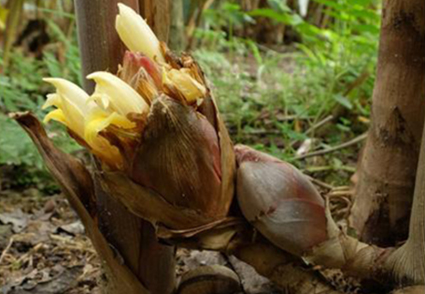Abstract
Amomum xizangense (Zingiberaceae), a new species from Xizang, China, is described and illustrated. It is similar to A. maximum and A. subcapitatum, but differs in having purple-red leaf sheath, purple-red or reddish-green petiole, lamina with purple-red midvein, persistent bracts and bracteoles, yellowish-white calyx, yellowish corolla, yellow anther with trilobed and yellow crest and globose fruit.
References
De Boer, H., Newman, M., Poulsen, A.D., Droop, A.J., Fér, T., Hi?n, L.T.T., Hlavatá, K., Lamxay, V., Richardson, J.E., Steffen, K.
& Leong-Škorni?ková, J. (2018) Convergent morphology in Alpinieae (Zingiberaceae): Recircumscribing Amomum as a monophyletic genus. Taxon 67 (1): 6–36. https://doi.org/10.12705/671.2
IUCN (2020) The IUCN Red List of Threatened Species. Version 2020-3. Available from: https://www.iucnredlist.org (accessed 10 October 2020)
Lamxay, V. & Newman, M.F. (2012) A revision of Amomum (Zingiberaceae) in Cambodia, Laos and Vietnam. Edinburgh Journal of Botany 69: 99–206. https://doi.org/10.1017/S0960428611000436
Larsen, K., Lock, J.M., Maas, H. & Maas, P.J.M. (1998) Zingiberaceae. In: Kubitzki, K. (Ed.) The Families and Genera of Vascular Plants. Springer Verlag, Berlin, pp. 474–495. https://doi.org/10.1007/978-3-662-03531-3_49
Linnaeus, C. (1792) Praelectiones in ordines naturales plantarum. Ed. Paulus Diet. Giseke. Impensis Benj. Gottl. Hoffmanni, Hamburgi [Hamburg], 662 pp.
Ridley, H.N. (1899) The Scitamineae of the Malay Peninsula. Journal of the Straits Branch of the Royal Asiatic Society 32: 85–184.
Roxburgh, W. (1810) Descriptions of several of the monandrous plants of India, belonging to the natural order called Scitamineae by Linnaeus, Cannae by Jussieu, and Drimyrhizae by Ventenat. Asiatic Researche 11: 75–344.
Roxburgh, W. (1820) Flora Indica; or Descriptions of Indian Plants, vol.1. Mission Press, Serampore, 474 pp.
WCSP (2020) World checklist of selected plant families in the catalogue of life. The catalogue of life partnership. Facilitated by the Royal Botanic Gardens, Kew. Available at: http://wcsp.science.kew.org/qsearch.do;jsessionid=41D148FCED90FC829BF2623BE07ED30B.kppapp05-wcsp (accessed 5 August 2020)
Wu, T.L. & Chen, S.J. (1987) Zingiberaceae. In: Wu, C.Y. (Ed.) Flora Xizangica, vol. 5. Science Press, Beijing, pp. 627–647.
Wu, T.L. & Larsen, K. (2000) Zingiberaceae. In: Wu, Z.Y. & Raven, P.H. (Eds.) Flora of China, vol. 24. Science Press, Beijing & Missouri Botanical Garden Press, St. Louis, pp. 322–377.
Xia, Y.M. (1997) A new species of Amomum (Zingiberaceae) from Yunnan, China. Acta Phytotaxonomica Sinica 35: 259–261.
Ye, X.E. (2018) Taxonomic studies on Amomum Roxb. in China. PhD Thesis, University of Chinese Academy of Sciences, Beijing, China, 192 pp.
& Leong-Škorni?ková, J. (2018) Convergent morphology in Alpinieae (Zingiberaceae): Recircumscribing Amomum as a monophyletic genus. Taxon 67 (1): 6–36. https://doi.org/10.12705/671.2
IUCN (2020) The IUCN Red List of Threatened Species. Version 2020-3. Available from: https://www.iucnredlist.org (accessed 10 October 2020)
Lamxay, V. & Newman, M.F. (2012) A revision of Amomum (Zingiberaceae) in Cambodia, Laos and Vietnam. Edinburgh Journal of Botany 69: 99–206. https://doi.org/10.1017/S0960428611000436
Larsen, K., Lock, J.M., Maas, H. & Maas, P.J.M. (1998) Zingiberaceae. In: Kubitzki, K. (Ed.) The Families and Genera of Vascular Plants. Springer Verlag, Berlin, pp. 474–495. https://doi.org/10.1007/978-3-662-03531-3_49
Linnaeus, C. (1792) Praelectiones in ordines naturales plantarum. Ed. Paulus Diet. Giseke. Impensis Benj. Gottl. Hoffmanni, Hamburgi [Hamburg], 662 pp.
Ridley, H.N. (1899) The Scitamineae of the Malay Peninsula. Journal of the Straits Branch of the Royal Asiatic Society 32: 85–184.
Roxburgh, W. (1810) Descriptions of several of the monandrous plants of India, belonging to the natural order called Scitamineae by Linnaeus, Cannae by Jussieu, and Drimyrhizae by Ventenat. Asiatic Researche 11: 75–344.
Roxburgh, W. (1820) Flora Indica; or Descriptions of Indian Plants, vol.1. Mission Press, Serampore, 474 pp.
WCSP (2020) World checklist of selected plant families in the catalogue of life. The catalogue of life partnership. Facilitated by the Royal Botanic Gardens, Kew. Available at: http://wcsp.science.kew.org/qsearch.do;jsessionid=41D148FCED90FC829BF2623BE07ED30B.kppapp05-wcsp (accessed 5 August 2020)
Wu, T.L. & Chen, S.J. (1987) Zingiberaceae. In: Wu, C.Y. (Ed.) Flora Xizangica, vol. 5. Science Press, Beijing, pp. 627–647.
Wu, T.L. & Larsen, K. (2000) Zingiberaceae. In: Wu, Z.Y. & Raven, P.H. (Eds.) Flora of China, vol. 24. Science Press, Beijing & Missouri Botanical Garden Press, St. Louis, pp. 322–377.
Xia, Y.M. (1997) A new species of Amomum (Zingiberaceae) from Yunnan, China. Acta Phytotaxonomica Sinica 35: 259–261.
Ye, X.E. (2018) Taxonomic studies on Amomum Roxb. in China. PhD Thesis, University of Chinese Academy of Sciences, Beijing, China, 192 pp.


